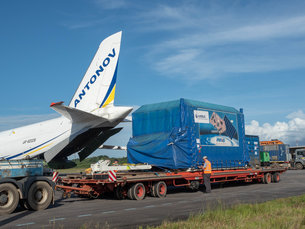10.07.2018

The MetOp-C launch campaign has kicked off with the first of three Antonovs landing at Cayenne Airport, French Guiana on 20 June.
The cargo aircraft transported 11 containers of equipment for ground support and IT-infrastructure, followed by the second, carrying the two main modules of the spacecraft a few days later. The third and final Antonov brought the solar array.
This is all in preparation for the launch of the third polar-orbiting satellite in the Meteorological Operational satellite programme. This programme was procured by ESA for Eumetsat, the European Organisation for the Exploitation of Meteorological Satellites.
The first two satellites were launched in 2006 and 2012. The launch of MetOp-C later this year will continue the success story of the most important set of sensors for weather prediction in space today.
Launching a new satellite every 5–6 years guarantees a continuous delivery of high-quality data for medium- and long-term weather forecasting and climate monitoring until at least 2023.
MetOp-A and -B are delivering considerable benefits to society by improving weather forecasts, thanks to their ability, among other features, to measure temperature and humidity profiles from a relatively close 800 km-altitude orbit. MetOp-C will ensure that these observations will also be available on a daily basis in the future.
The economic and social benefits of accurate weather forecasts are huge, with the potential to impact on crop harvesting, air traffic, and simply planning day-to-day activities. In the extreme, knowing that hazardous weather conditions are on the way can save human life and property.
ESA’s MetOp-C project manager, Stéfane Carlier, said, “MetOp has brought about a new era in the way Earth's weather, climate and environment are observed and has significantly improved operational meteorology, particularly numerical weather predictions.
“The MetOp-A and -B satellites contribute approximately one third to numerical weather prediction from all data sources, including in situ, airborne and space-based.
“MetOp-C will ensure the continuity of the provision of this service until the next generation of MetOp spacecraft enters into service and provides even more refined data.”
Eumetsat Polar System Programme Scientist, Dr Dieter Klaes, said, “The Infrared Atmospheric Sounding Interferometer (IASI) is MetOp’s key instrument for numerical weather prediction. It has been central to the significant improvement in weather forecasts up to 10 days ahead, over the past decade.
“MetOp satellites remain advanced technology and their instruments are still state-of-the art. We expect that adding an additional source of information, when MetOp-C is operational, will have further positive impact on forecast quality.”
Quelle: ESA

